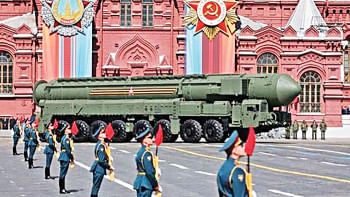Los Alamos during and after the Manhattan Project

Anyone who has watched Christopher Nolan's epic Oppenheimer has gotten a glimpse of the life, legacy, rise and subsequent fall of the "American Prometheus" J Robert Oppenheimer, leader of the Manhattan Project – the code name of the top-secret atomic-bomb-making effort at Los Alamos Scientific Laboratory in New Mexico, US. While the film captured the involvement of many famous scientists who changed the course of the world's history, the role of some prominent female scientists, particularly Maria Goeppert Mayer, was conspicuously absent. Moreover, except for Oppenheimer's house, outdoor scenes were shot at Ghost Ranch in the nearby village of Abiquiú. Hence, the movie did not show what life in Los Alamos was like in those days.
I lived in Los Alamos and worked at the lab in the mid-1980s and was a visiting scientist during the summer months between 1990 and 2006. Los Alamos is located in an obscure corner at the southwestern edge of the Rocky Mountains atop the 2,250-metre high Pajarito Plateau, a volcanic region of mesas and canyons. Before 1943, it was unknown to the world. Between 1943 and the end of World War II, one mailbox – PO Box 1663 in Santa Fe – was the mailing address for the entire town. Its existence, nevertheless, remained secret.
During the Manhattan Project, Los Alamos was a ramshackle town of temporary buildings housing thousands of scientists, engineers, technicians, military personnel and their families. Faculty quarters of the Los Alamos Ranch School on The Bathtub Row, aptly named as they had bathtubs instead of showers, were allocated to the senior scientists, including Oppenheimer. The school was converted into the research centre of the lab. It is now a museum, containing, among other historical exhibits, unclassified documents and pictures that bring to life the thought process behind fabricating a world-changing weapon of mass destruction.
Secrecy was paramount at the lab. Everyone living in Los Alamos – children aged six and above, too – needed security clearance. Along with barbed wire fences, armed guards protected the perimeter of the lab. To access the classified areas of the lab, employees had to go through multiple security checkpoints.
Employees were sequestered away from the outside world. They were not allowed to tell their spouses and children what they were working on. Any chance encounter with people not working at the lab had to be reported to the security office. The security team warned the residents to cancel all magazine subscriptions and cautioned the scientists to never use their real names. Accordingly, Enrico Fermi was "Henry Farmer" and Neils Bohr was "Nicholas Baker." The word physicist was forbidden; everyone was an engineer. Quite appropriately, Edward Teller described Los Alamos as a "wildlife reserve for physicists."
Recreational facilities were few and far between. Until 1945, there was only one telephone line, one radio station and one commissary (a military-operated supermarket) where residents did their grocery shopping.
In those days, Los Alamos could only be accessed by narrow, twisty, dirt roads that turned into a muddy mess during the rainy season. Now, roads are paved and have multiple lanes, but there are no commercial flights or train service. For employees of the lab, the US Department of Energy (DOE) operates flights to and from Albuquerque.
After the war ended, the word "Scientific" in the name of the lab was changed to "National." Also, the town's shroud of secrecy was lifted. However, the Manhattan Project sites are still off-limits to the public. They can see references to the project everywhere though, with names such as "Atomic City" Transit, "Oppenheimer" Drive and "Trinity" Street.
In those days, Los Alamos could only be accessed by narrow, twisty, dirt roads that turned into a muddy mess during the rainy season. Now, roads are paved and have multiple lanes, but there are no commercial flights or train service. For employees of the lab, the US Department of Energy (DOE) operates flights to and from Albuquerque.
Although developing and maintaining the nuclear weapons arsenal of the US remains the lab's primary mission, it is now one of the world's premier institutes for doing cutting-edge research at the frontier of science and engineering, as well as finding innovative solutions to fight climate change. More than 6,000 of the world's leading scientists with the highest level of education presently work in the lab. People with doctorate degrees cluster in such high numbers that anyone with a master's degree can feel like a second-class citizen of Los Alamos.
During my stint at the lab, we had to go through most of the security protocols of the Manhattan Project days. We were fingerprinted, photographed and told that the "security badge" cannot be used as an identification card outside the lab. For our safety, we were advised not to display anything in public, especially outside New Mexico, that would indicate that we work at the lab. In case of foreign travel, we were required to submit a copy of the itinerary to the DOE at least a week before departure.
As for life in the 1980s, it was decidedly predictable; imagination and zest were overcome by boring routine. Diversity in life was essentially nonexistent and the pace of change was snail-like. The town's character and conservative nature was accentuated by the bunker mentality among the population. So deeply entrenched were the residents in their status as a protected community that they feared that people from the outside world would bring a crime wave.
Social life was rather tame. There was only one movie house, a golf course, limited shopping, a few restaurants and a couple of bars. By 8pm, even on a weekend, the town became deserted.
Today, Los Alamos is a quaint tight-knit community with the best education system in the state. Part of the town is toxic because of the "legacy waste" and carcinogenic remnants of chromium that were flushed into a nearby canyon between 1956 and 1972.
With high-paying research jobs, Los Alamos has more millionaires per capita than any other town in the US. Their playground is the culturally and gastronomically alluring Santa Fe – the capital city.
Outdoor recreation in Los Alamos is available beyond everyone's doorstep. The Jemez Mountains, with an average elevation of 3,500 metres, offer a fantastic base for hiking, camping, rafting, skiing, and many more. Besides, the beauty of the landscape, enhanced by dramatic changes in terrain and elevation, is a treat for nature lovers. Compared to a comfortable yet mundane life in Los Alamos today, during the Manhattan Project years, it was chaotic, penal-like, and marked by hardships. As noted by Oppenheimer, despite leading a Spartan life, these "heroes of today will be criticised for what you have done here."
Dr Quamrul Haider is professor emeritus at Fordham University in New York, US.
Views expressed in this article are the author's own.
Follow The Daily Star Opinion on Facebook for the latest opinions, commentaries and analyses by experts and professionals. To contribute your article or letter to The Daily Star Opinion, see our guidelines for submission.

 For all latest news, follow The Daily Star's Google News channel.
For all latest news, follow The Daily Star's Google News channel. 








Comments